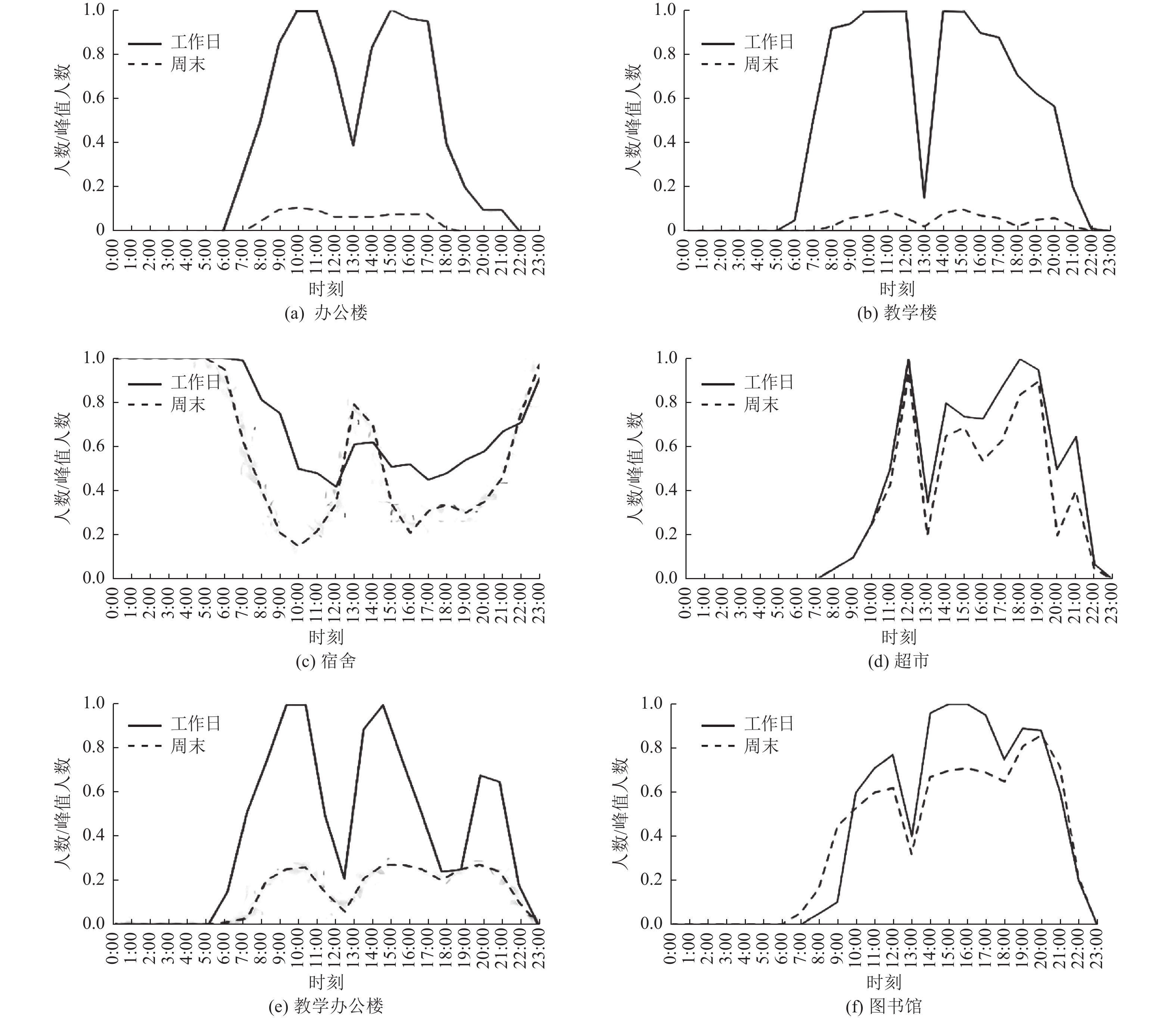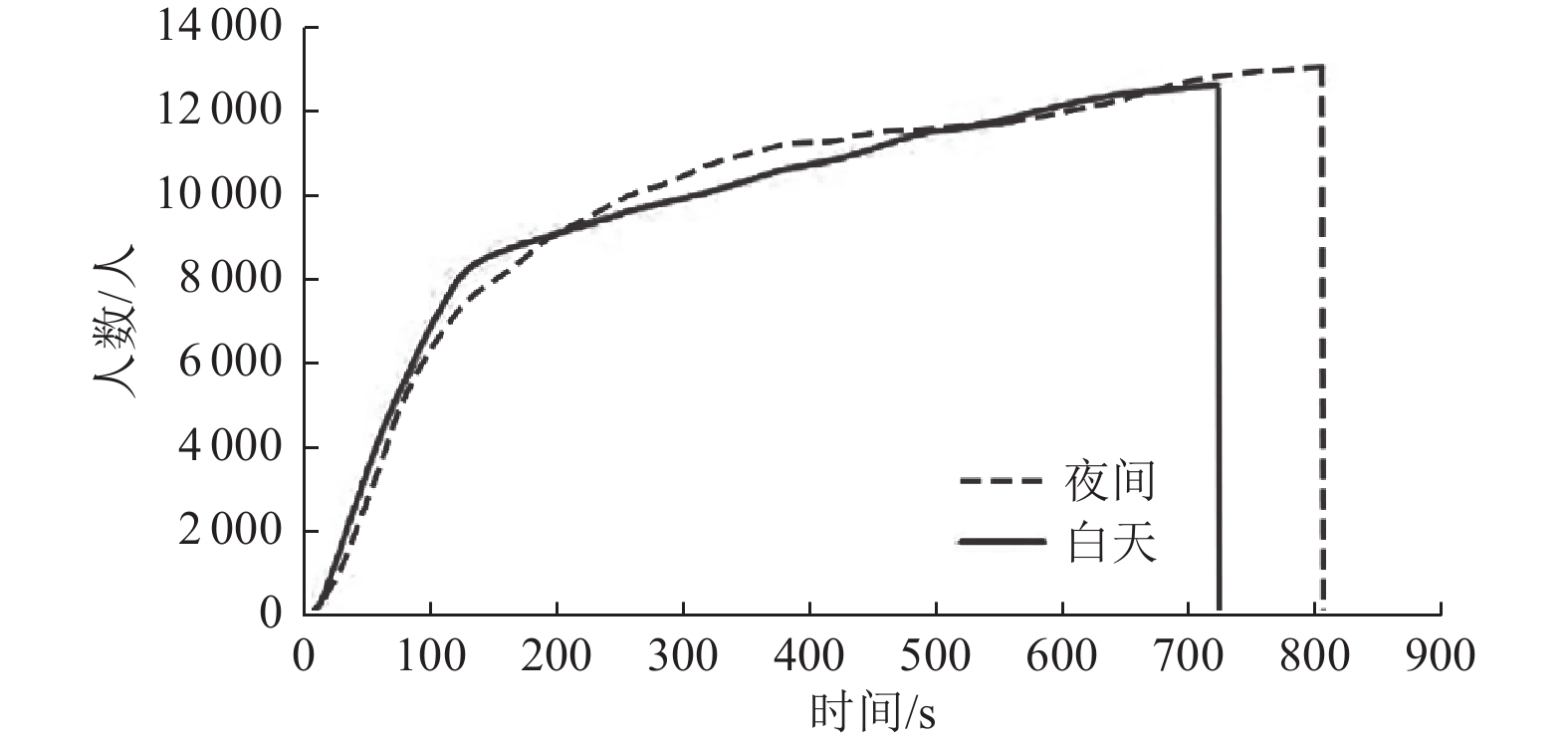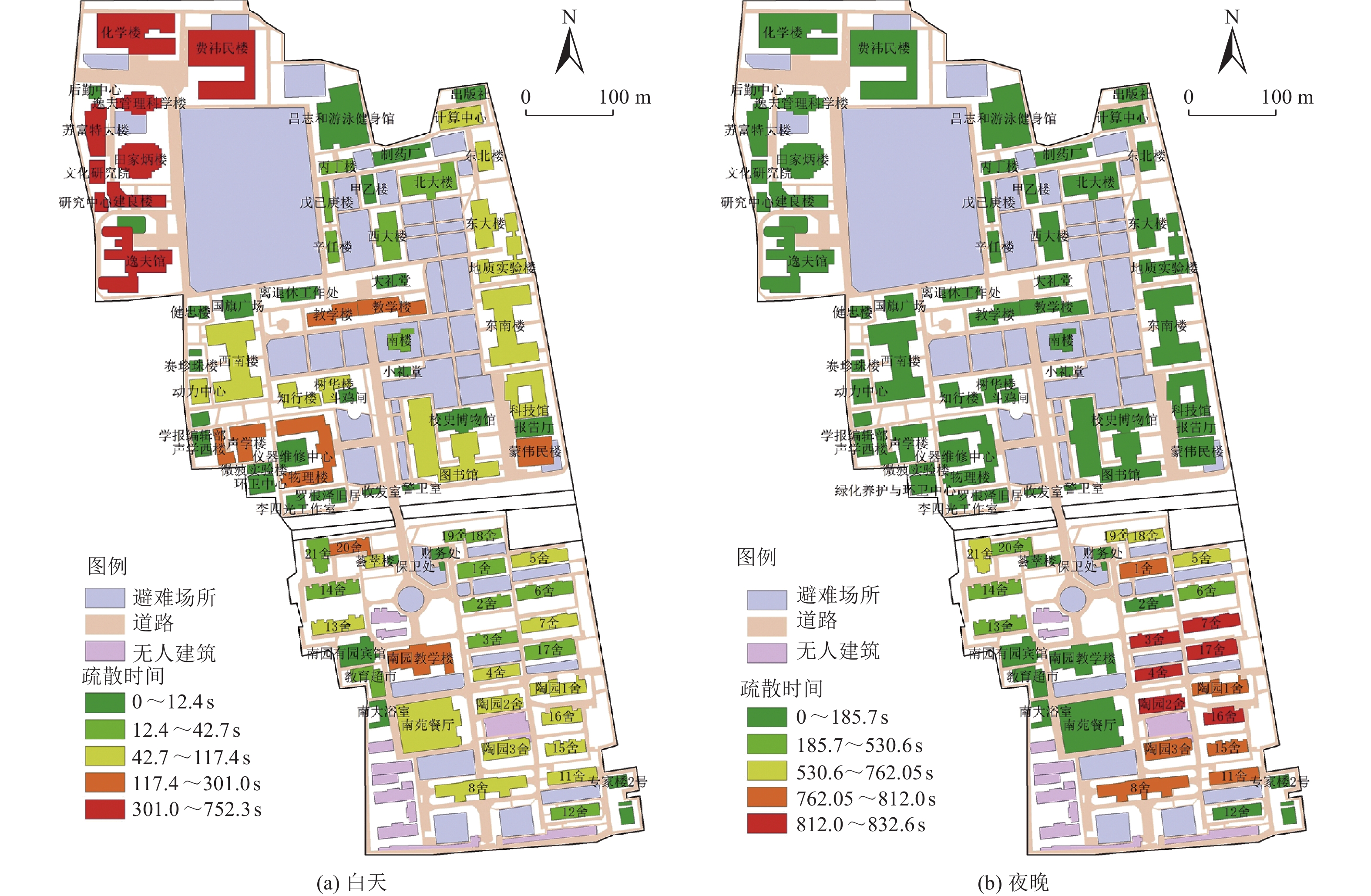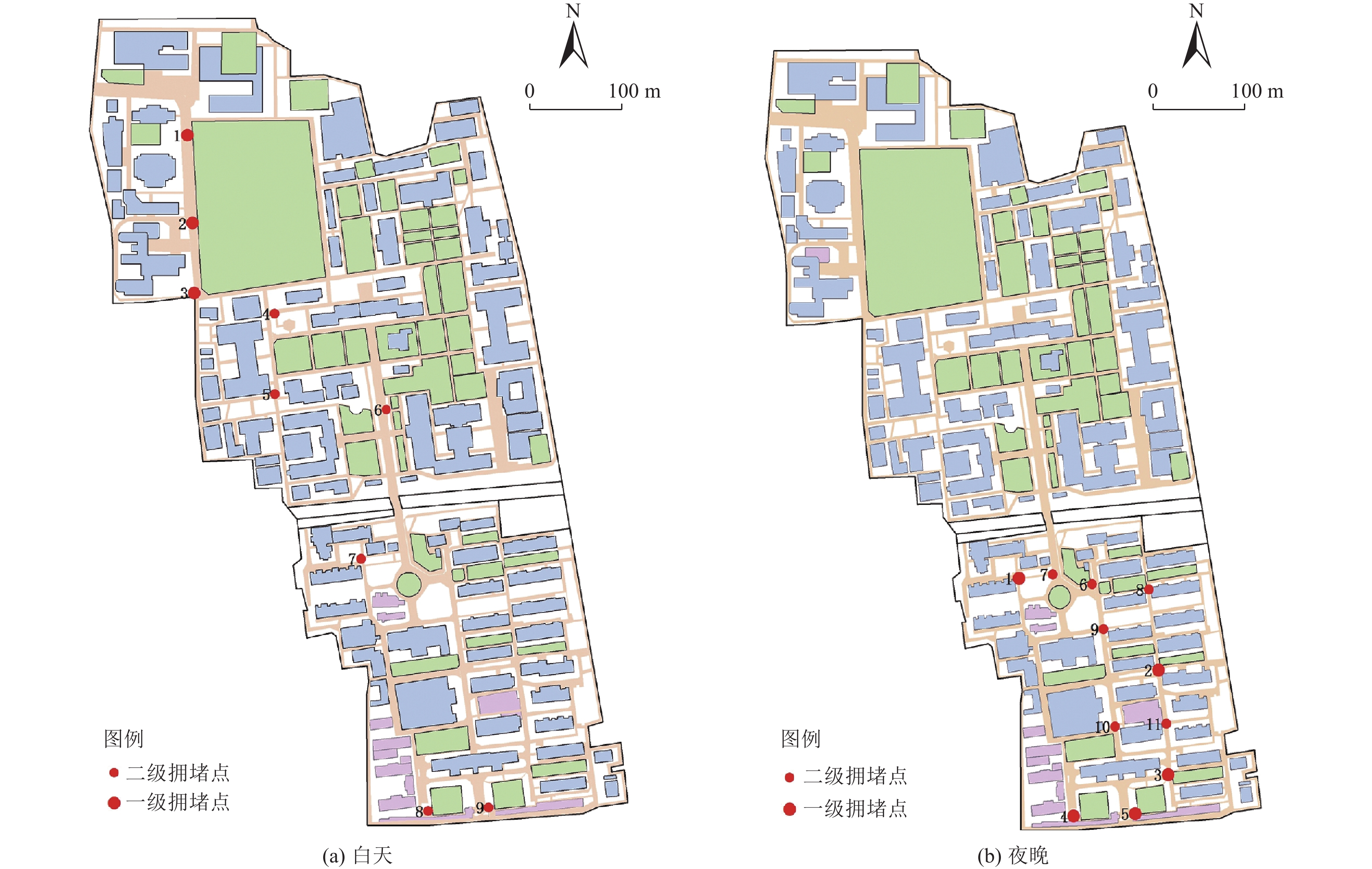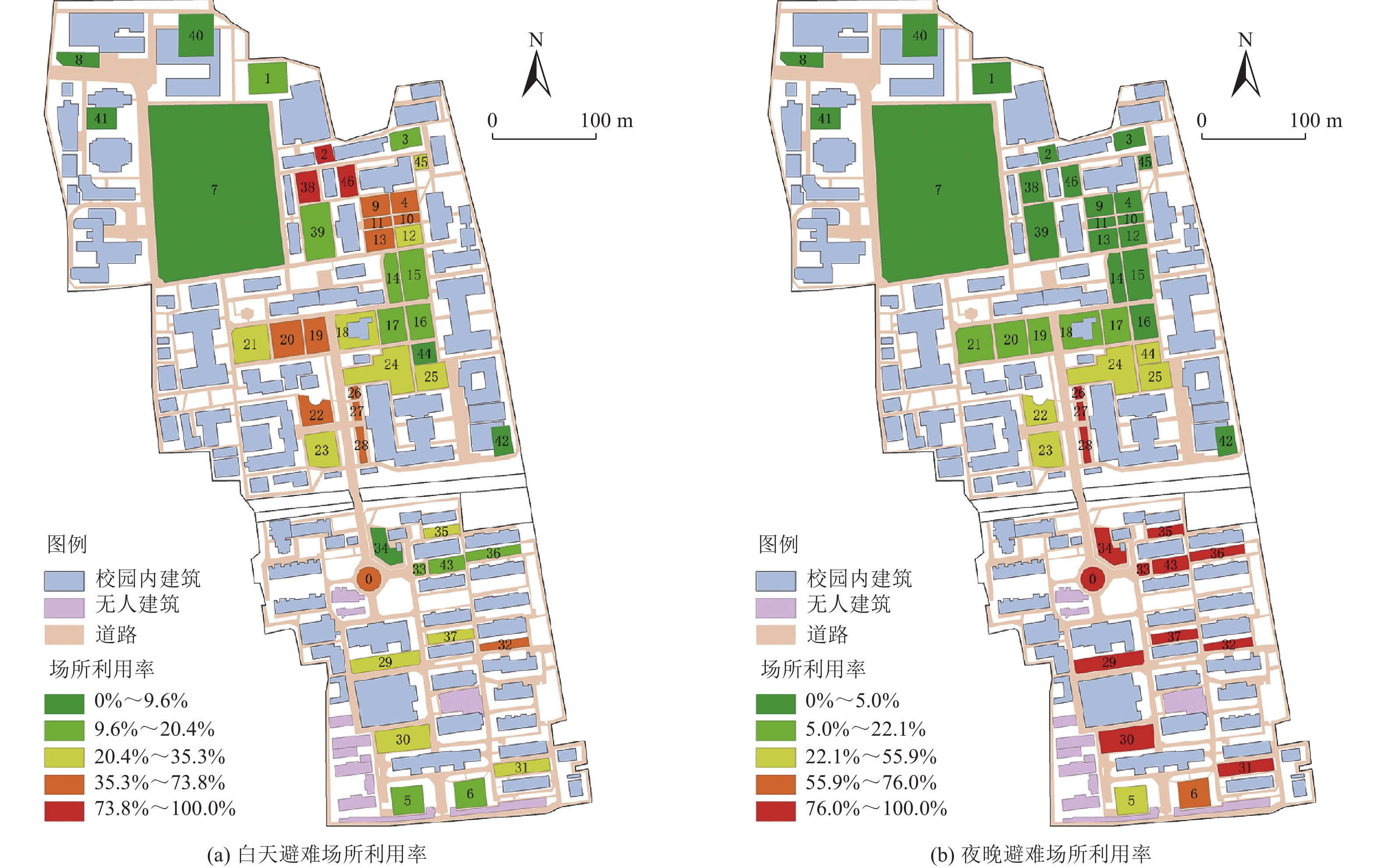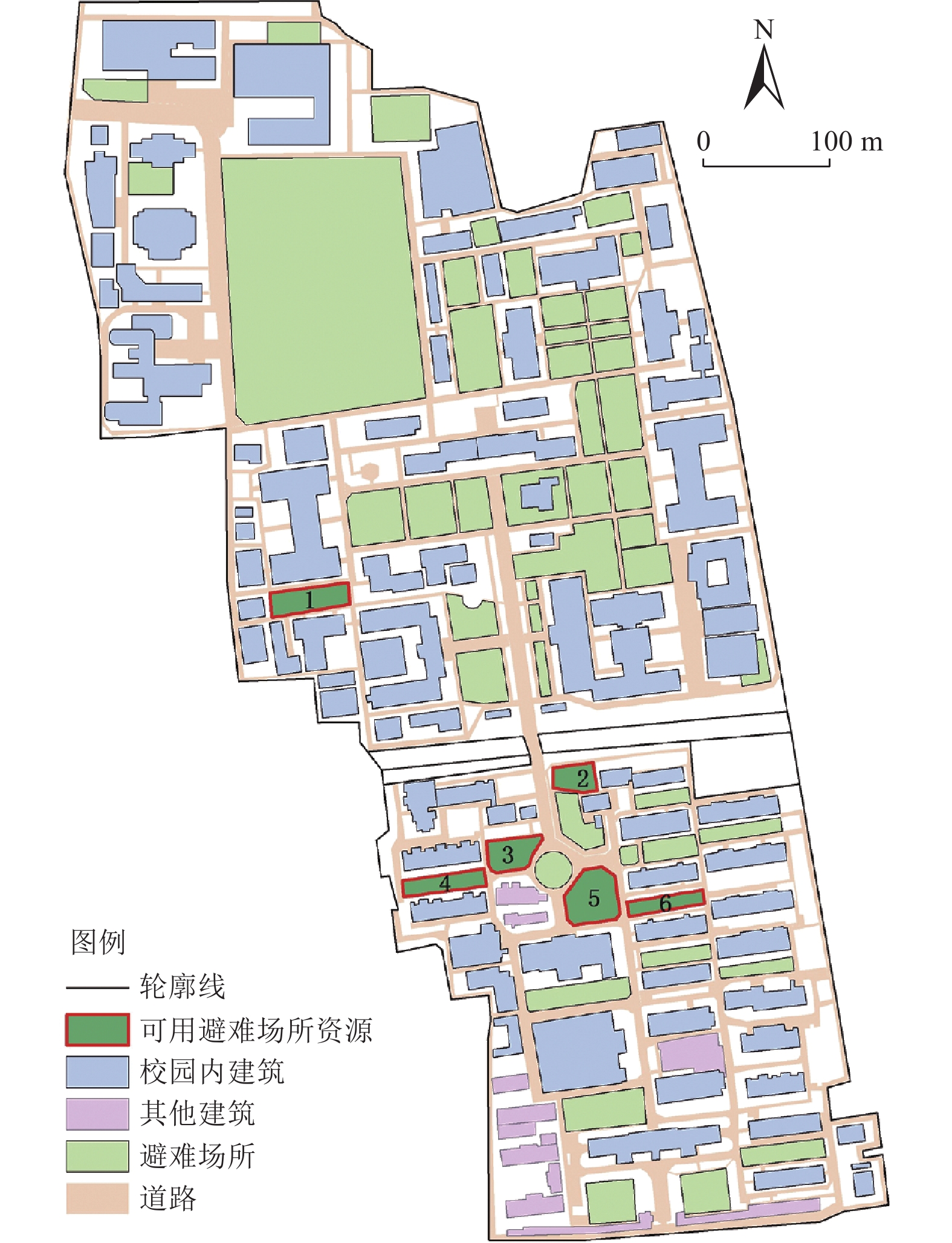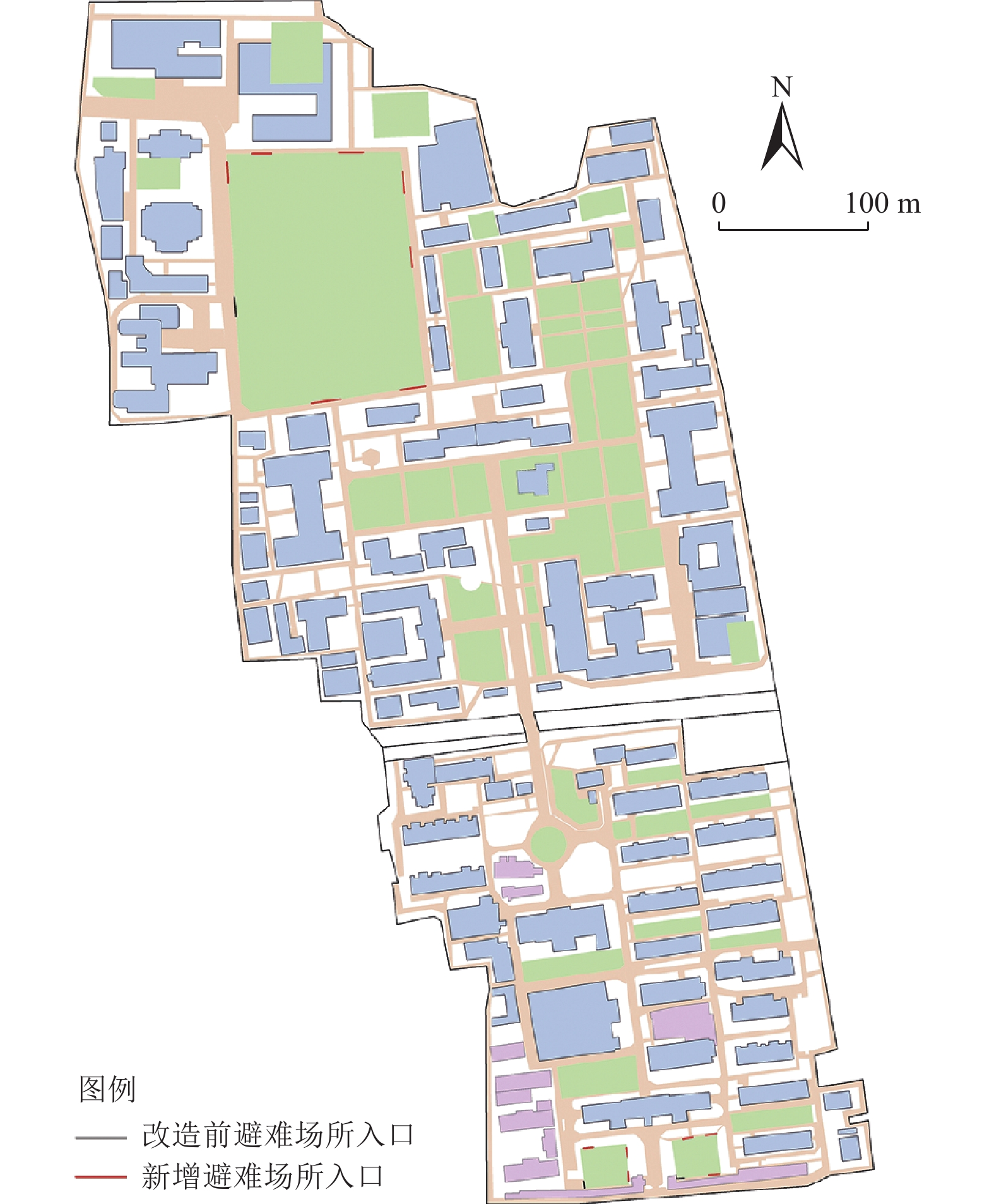Optimization of Refuge Space in Urban High-density Area Based on Multi-agent Evacuation Simulation −Taking A University Campus in Nanjing as An Example
-
摘要: 选取南京市某高校校园为研究对象,通过实地调研获取人口分布、道路网络、建筑布局、避难空间等基础数据,通过开展问卷调查获取人群避难场所选择偏好、避难路径选择等典型疏散行为参数。在Pathfinder应急疏散平台中建立多智能体疏散仿真模型,对白天和夜晚情况进行疏散模拟,基于疏散模拟结果,从空间环境、应急管理层面提出更新优化策略并完成仿真模拟验证。调查结果表明,校园内人群对避难场所的选择偏好依次为:场地型避难场所、建筑型避难场所、地下空间,避难场所偏好选择与调查对象性别相关;校园建筑全天的人口数量变化因建筑功能不同有较大差异,白天疏散时间显著少于夜晚,白天拥堵位置多出现在北园教学区,夜晚拥堵位置出现在南园宿舍区;宿舍区利用率高于教学区,大面积的避难场所(如操场、篮球场等)利用率反而处于较低水平。对改造后的校园区域进行疏散模拟验证,结果表明疏散完成时间显著减少、拥堵点人口密度下降,证明了改造措施的有效性。Abstract: Taking a university campus in Nanjing as the research object, the basic data of population distribution, road network, building layout, refuge space and so on were obtained through field investigation, and a questionnaire survey was carried out to obtain typical evacuation behavior parameters such as people's choice of refuge places and refuge paths. A multi-agent evacuation simulation model is established in the Pathfinder emergency evacuation platform to simulate the evacuation in the daytime and at night. Based on the evacuation simulation results, an update optimization strategy was proposed and validated from the spatial environment and emergency management levels. The results of the study show that the preference of the people on campus for the choice of refuge place is: site type shelter > building type shelter > underground space and the preference of shelter is related to the gender of the survey respondents; the change of the 24-hour population in campus buildings varies greatly depending on the building functions; the evacuation time during daytime is significantly less than that at night; the congested locations are mostly found in the North Campus teaching area during the daytime, and the congested locations at night are found in the South Campus dormitory area; the utilization rate of the dormitory area is higher than that of the teaching area, while the utilization rate of large evacuation areas such as playgrounds and basketball courts is at a lower level. The results show that the evacuation completion time is significantly reduced and the population density at the congestion point is reduced, which proves the effectiveness of the reconstruction measures.
-
表 1 疏散行为决策问卷调查设计
Table 1. Design of questionnaire for evacuation behavior decision making
问题 选项 性别 ①男;②女 地震后倾向于逃往的避难场所(多选) ①大型体育馆;②操场;③公园绿地;④地下车库;⑤露天停车场 疏散过程中发生拥堵时的选择 ①排队等待;②寻找其他疏散通道 进入避难场所入口处发生拥堵的选择 ①排队等待;②寻找其他避难场所 表 2 避难场所选择偏好
Table 2. Choice preference of refuge place
性别 是否选择地下车库 是否选择大型体育馆 小计 是 否 男 是 占比2.78%,人数4 占比2.78%,人数4 人数144 否 占比13.89%,人数20 占比80.56%,人数116 女 是 占比0%,人数0 占比0%,人数0 人数123 否 占比6.50%,人数8 占比93.5%,人数115 表 3 疏散过程拥堵时的路径选择
Table 3. Route selection during evacuation congestion
性别 避难通道拥堵 避难场所入口拥堵 小计 排队等待 另外寻找其他避难场所 男 排队等待 占比22.76%,人数33 占比2.76%,人数4 人数144 另外寻找其他疏散通道 占比30.34%,人数43 占比44.14%,人数64 女 排队等待 占比20.32%,人数25 占比3.25%,人数4 人数123 另外寻找其他疏散通道 占比39.84%,人数49 占比36.59%,人数45 表 4 应急避难场所规划标准
Table 4. Planning standards for emergency shelters
场所类型 人均有效避难面积/m2 疏散距离/km 避难人口规模/万人 中心避难场所 >4.5 5.0~10.0 — 长期固定避难场所 4.5 ≤2.5 ≤9.0 中期固定避难场所 3.0 ≤1.5 ≤2.3 短期固定避难场所 2.0 ≤1.0 ≤0.5 紧急避难场所 1.0 ≤0.5 — -
陈伟, 翟国方, 张义杰, 2019. 基于手机信令数据的人口高精度时空分布特征研究——以天津市小白楼CBD片区为例. 资源开发与市场, 35(10): 1266—1272 doi: 10.3969/j.issn.1005-8141.2019.10.008Chen W. , Zhai G. F. , Zhang Y. J. , 2019. High-precision spatial and temporal distribution of population based on mobile phone data——A case of Xiaobailou CBD area in Tianjin city. Resource Development & Market, 35(10): 1266—1272. (in Chinese) doi: 10.3969/j.issn.1005-8141.2019.10.008 丁琳, 翟国方, 李莎莎, 2015. 多灾种应对的城市综合避难场所规划研究. 城市规划, 39(9): 107—112 doi: 10.11819/cpr20150918aDing L. , Zhai G. F. , Li S. S. , 2015. Planning for urban comprehensive evacuation shelters for better response to disasters. City Planning Review, 39(9): 107—112. (in Chinese) doi: 10.11819/cpr20150918a 窦凯丽, 陈畅, 2016. 基于NetLogo建模的城市防灾应急疏散模拟研究−以某大城市校园人群疏散为例. 见: 规划60年: 成就与挑战−2016中国城市规划年会论文集(01城市安全与防灾规划). 北京: 中国建筑工业出版社, 13—22. 范晨璟, 翟国方, 2018. 综合防灾背景下城市地下空间开发利用策略研究. 见: 共享与品质−2018中国城市规划年会论文集(01城市安全与防灾规划). 北京: 中国建筑工业出版社, 228—235. 黄丽蒂, 许欣欣, 刘莹等, 2020. 东北老龄化社区路网疏散仿真模拟及优化. 中国安全科学学报, 30(7): 127—132 doi: 10.16265/j.cnki.issn1003-3033.2020.07.019Huang L. D. , Xu X. X. , Liu Y. , et al. , 2020. Simulation and optimization of road network evacuation in communities for elderly people in Northeast China. China Safety Science Journal, 30(7): 127—132. (in Chinese) doi: 10.16265/j.cnki.issn1003-3033.2020.07.019 李辉鹏, 柳善耀, 刘丹等, 2020. 考虑恐慌影响的高校食堂应急疏散仿真研究. 武汉理工大学学报(信息与管理工程版), 42(4): 373—377 doi: 10.3963/j.issn.2095-3852.2020.04.014Li H. P. , Liu S. Y. , Liu D. , et al. , 2020. Simulation study on emergency evacuation of university canteen considering the impact of panic. Journal of Wuhan University of Technology (Information & Management Engineering), 42(4): 373—377. (in Chinese) doi: 10.3963/j.issn.2095-3852.2020.04.014 李亚, 翟国方, 2017. 我国城市灾害韧性评估及其提升策略研究. 规划师, 33(8): 5—11 doi: 10.3969/j.issn.1006-0022.2017.08.001Li Y. , Zhai G. F. , 2017. China's urban disaster resilience evaluation and promotion. Planners, 33(8): 5—11. (in Chinese) doi: 10.3969/j.issn.1006-0022.2017.08.001 李引擎, 2010. 多层综合交通枢纽防灾设计. 北京: 中国建筑工业出版社. 梁琦, 2020. 基于Anylogic仿真模拟的沈阳农业大学防灾避险绿地研究. 沈阳: 沈阳农业大学.Liang Q., 2020. Study on the disaster prevention and risk avoidance green space of Shenyang agricultural university based on the simulation of anylogic. Shenyang: Shenyang Agricultural University. (in Chinese) 刘莹, 邢凯, 2015. 人群仿真在体育馆疏散设计中的应用. 新建筑, (5): 36—39 doi: 10.3969/j.issn.1000-3959.2015.05.009Liu Y. , Xing K. , 2015. Application of crowd simulation in gymnasium egress design. New Architecture, (5): 36—39. (in Chinese) doi: 10.3969/j.issn.1000-3959.2015.05.009 饶平, 周晓冬, 朱孔金等, 2011. 复杂建筑结构人员疏散的元胞自动机模拟研究. 中国安全科学学报, 21(12): 34—39 doi: 10.3969/j.issn.1003-3033.2011.12.005Rao P. , Zhou X. D. , Zhu K. J. , et al. , 2011. Cellular automation simulation of pedestrian evacuation under complex building structure. China Safety Science Journal, 21(12): 34—39. (in Chinese) doi: 10.3969/j.issn.1003-3033.2011.12.005 撒占友, 程卫民, 2012. 安全人机工程. 徐州: 中国矿业大学出版社. 沙云飞, 2008. 人群疏散的微观仿真模型研究. 北京: 清华大学.Sha Y. F., 2008. Studies on microscopic simulation model of pedestrian evacuation. Beijing: Tsinghua University. (in Chinese) 宋英华, 张宇, 霍非舟等, 2020. 考虑避让行为的人员疏散元胞自动机模型研究. 系统仿真学报, 32(6): 975—981 doi: 10.16182/j.issn1004731x.joss.20-0195Song Y. H. , Zhang Y. , Huo F. Z. , et al. , 2020. Study on evacuation cellular automaton model considering avoidance behavior. Journal of System Simulation, 32(6): 975—981. (in Chinese) doi: 10.16182/j.issn1004731x.joss.20-0195 孙澄, 王燕语, 范乐, 2018. 基于疏散模拟的东北地区居住区路网结构优化策略研究. 建筑学报, (2): 38—43 doi: 10.3969/j.issn.0529-1399.2018.02.007Sun C. , Wang Y. Y. , Fan L. , 2018. A study on the optimal strategies of community road network in northeast China based on evacuation simulation. Architectural Journal, (2): 38—43. (in Chinese) doi: 10.3969/j.issn.0529-1399.2018.02.007 田玉敏, 2013. 特殊人群疏散行为及疏散设计的研究. 灾害学, 28(3): 91—94 doi: 10.3969/j.issn.1000-811X.2013.03.017Tian Y. M. , 2013. Study on evacuation behaviors of the special growd and the evacuation design for them. Journal of Catastrophology, 28(3): 91—94. (in Chinese) doi: 10.3969/j.issn.1000-811X.2013.03.017 王锟, 盛武, 段若男, 2016. 基于Pathfinder的高校教学楼出口人员疏散仿真研究. 中国安全生产科学技术, 12(7): 180—186Wang K. , Sheng W. , Duan R. N. , 2016. Research on personnel evacuation simulation from exits of university teaching building based on Pathfinder. Journal of Safety Science and Technology, 12(7): 180—186. (in Chinese) 王燕语, 2020. 东北城市居住区安全疏散优化策略研究. 哈尔滨: 哈尔滨工业大学.Wang Y. Y., 2020. Optimal strategy research on safety evacuation of urban residential area in northeast China. Harbin: Harbin Institute of Technology. (in Chinese) 於家, 温家洪, 陈芸等, 2017. 基于应急疏散智能体模型模拟的城市避难所空间配置——以上海市静安区为例. 地理学报, 72(8): 1458—1475 doi: 10.11821/dlxb201708010Yu J. , Wen J. H. , Chen Y. , et al. , 2017. Spatial configuration of urban shelters based on simulation using emergency evacuation agent-based model: a case study in Jing'an District, Shanghai. Acta Geographica Sinica, 72(8): 1458—1475. (in Chinese) doi: 10.11821/dlxb201708010 钟光淳, 翟国方, 葛懿夫, 2021. 突发灾害事件情境下人群疏散研究进展. 灾害学, 36(4): 221—227 doi: 10.3969/j.issn.1000-811X.2021.04.036Zhong G. C. , Zhai G. F. , Ge Y. F. , 2021. Research progress and prospects of crowd evacuation under sudden disasters. Journal of Catastrophology, 36(4): 221—227. (in Chinese) doi: 10.3969/j.issn.1000-811X.2021.04.036 中华人民共和国住房和城乡建设部, 中华人民共和国国家质量监督检验检疫总局, 2015. GB 51143—2015 防灾避难场所设计规范. 北京: 中国标准出版社.Ministry of Housing and Urban-Rural Development of the People’s Republic of China, General Administration of Quality Supervision, Inspection and Quarantine of the People's Republic of China, 2015. GB 51143—2015 Code for Design of Disasters Mitigation Emergency Congregate Shelter. Beijing: Standards Press of China. (in Chinese) 左进, 史吉康, 2019. 基于Anylogic仿真模拟的高密度传统街区应急疏散研究——以天津小白楼五号地为例. 南方建筑, (3): 82—88 doi: 10.3969/j.issn.1000-0232.2019.03.082Zuo J. , Shi J. K. , 2019. Research on the emergency evacuation of traditional blocks of high density using anylogic: site No. 5 of Tianjin Xiao Bai Lou used as an example. South Architecture, (3): 82—88. (in Chinese) doi: 10.3969/j.issn.1000-0232.2019.03.082 Burstedde C., Klauck K., Schadschneider A., et al., 2001. Simulation of pedestrian dynamics using a two-dimensional cellular automaton. Physica A: Statistical Mechanics and its Applications, 295(3—4): 507—525. Chen Y. M. , Wang C. , Yap J. B. H. , et al. , 2020. Emergency evacuation simulation at starting connection of cross-sea bridge: case study on Haicang Avenue Subway Station in Xiamen Rail Transit Line. Journal of Building Engineering, 29: 101163. doi: 10.1016/j.jobe.2019.101163 Gwynne S. , Galea E. R. , Lawrence P. J. , et al. , 1999. A review of the methodologies used in the computer simulation of evacuation from the built environment. Building and Environment, 34(6): 741—749. doi: 10.1016/S0360-1323(98)00057-2 Helbing D. , Molnár P. , 1995. Social force model for pedestrian dynamics. Physical Review E, 51(5): 4282—4286. doi: 10.1103/PhysRevE.51.4282 Lindell M. K. , 2008. EMBLEM2: an empirically based large scale evacuation time estimate model. Transportation Research Part A: Policy and Practice, 42(1): 140—154. doi: 10.1016/j.tra.2007.06.014 Pan X. S. , Han C. S. , Dauber K. , et al. , 2007. A multi-agent based framework for the simulation of human and social behaviors during emergency evacuations. AI & Society, 22(2): 113—132. Pauls J. , 1987. Calculating evacuation times for tall buildings. Fire Safety Journal, 12(3): 213—236. doi: 10.1016/0379-7112(87)90007-5 Togawa K., 1995. Study of fire escapes basing on the observations of multiple currents. Tokyo, Japan: Building Research Institute, Ministry of Construction, 24—28. Xiao M. L. , Zhang Y. , Liu B. Y. , 2017. Simulation of primary school-aged children's earthquake evacuation in rural town. Natural Hazards, 87(3): 1783—1806. doi: 10.1007/s11069-017-2849-8 Zuo J. , Shi J. K. , Li C. , et al. , 2021. Simulation and optimization of pedestrian evacuation in high-density urban areas for effectiveness improvement. Environmental Impact Assessment Review, 87: 106521. doi: 10.1016/j.eiar.2020.106521 -




 下载:
下载:
